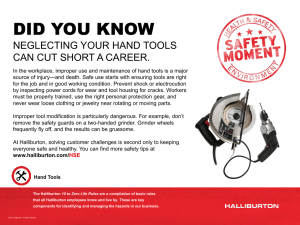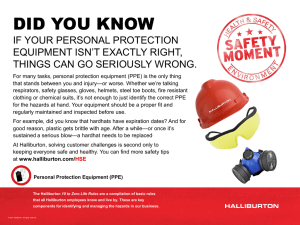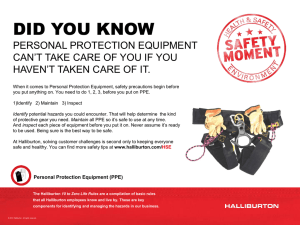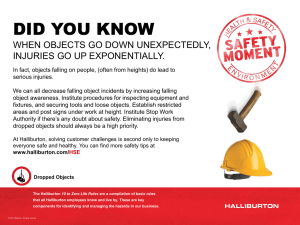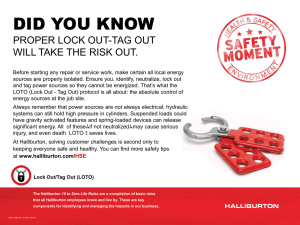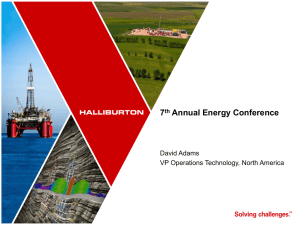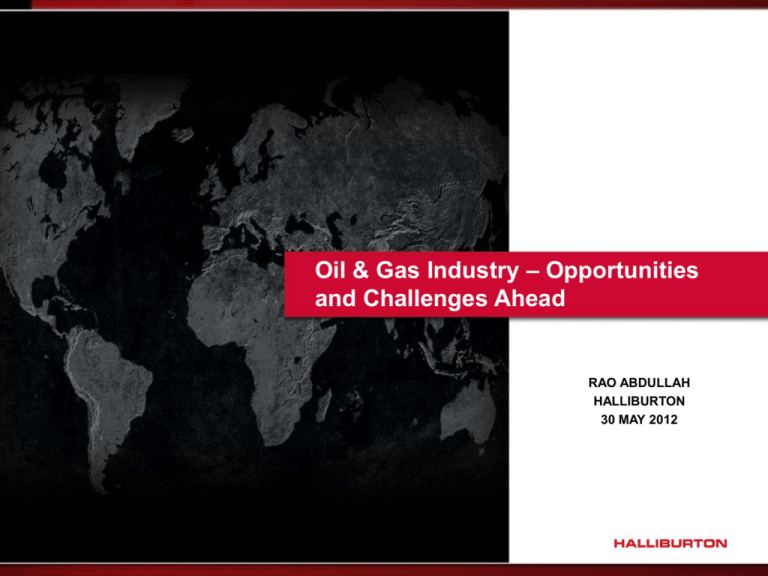
Oil & Gas Industry – Opportunities
and Challenges Ahead
RAO ABDULLAH
HALLIBURTON
30 MAY 2012
Content
Safety message
Quick look at Malaysian oil & gas sector
Opportunities and challenges
–
–
–
–
–
Enhance oil recovery
Marginal & mature fields
Deepwater
High-Pressure & High-Temperature
CO2
Conclusion
Question & Answer
© 2012 HALLIBURTON. ALL RIGHTS RESERVED.
2
Safety Moment – Distracted Driving
DANGEROUS: A driver and motorcyclist
busy talking and texting on the phone
without regard to the danger they face. —
Bernama photo
© 2012 HALLIBURTON. ALL RIGHTS RESERVED.
© 2012 HALLIBURTON. ALL RIGHTS RESERVED.
Statistics show that one in four car crashes is
caused by a person using a cell phone while
driving
Doesn‟t matter if it is a hand-held or a hands-free
device
Driving while distracted is a factor in 25 percent of
police reported crashes
Experts say that using hand-held or hands-free
cell phones while driving produces the same
effect in a driver as someone driving with a blood
alcohol level of .08 percent. Studies conducted in
developed nations, such as the United States,
Sweden and Japan, have already shown that the
risk of accidents is 4-5 times greater when drivers
are drunk or are using hand phones.
Cell phone use while driving reduces the amount
of brain activity associated with driving by 37%
3
Oil, Gas and Energy Industry in Malaysia
Where we are today
Vision for the future
The oil, gas and energy
sector is the mainstay of
Malaysia's growth
By 2020, Malaysia will have a more
diversified oil, gas and energy sector
that remains vital to our development,
and that builds on the nation’s
competitive advantages
Contributes approx. 20%
of national GDP
© 2012 HALLIBURTON. ALL RIGHTS RESERVED.
Key thrust: to intensify exploration and
enhance production from domestic
reserves
Develop a strong regional oilfield services
& equipment hub, and a stronger presence
in the regional midstream logistics and
downstream markets
Potential to grow alternative energy
sources such as nuclear, solar and
hydro to overcome decline in natural
gas
production
4
Oil was first discovered in Malaysia in 1910 in
Miri, Sarawak. Since then, two other groundbreaking events have helped shape Malaysia‟s
Oil & Gas industry. First, Malaysia‟s Parliament
passed the Petroleum Development Act and
second, Petroliam Nasional Berhad or
PETRONAS was established to manage the
country‟s petroleum resources. It also provides
support in terms of resource planning,
distribution and marketing.
PETRONAS
at a Glance
PETRONAS, the acronymn for
Petroliam Nasional Berhad, was
incorporated on 17 August 1974 under
the Companies Act, 1965. It is whollyowned by the Malaysian Government
and is vested with the entire ownership
and control of the petroleum resources
in Malaysia through the Petroleum
Development Act, 1974. Over the
years, PETRONAS has grown to
become a fully integrated oil and gas
corporation and is ranked among the
FORTUNE Global 500® largest
corporations in the world.
© 2012 HALLIBURTON. ALL RIGHTS RESERVED.
Exploration Acreages
Malaysia has approximately 615,100 square kilometres of acreages available for
oil and gas exploration. Of these, 218,678 square kilometres or 36% of the total
acreages are currently covered by Production Sharing Contracts.
Exploration drilling in Malaysia by the Production Sharing Contractors has
resulted in the discovery of 163 oil fields and 216 gas fields. Many significant
discoveries were made in shelfal shallow waters as well as in deepwater
environments.
Increasingly, new discoveries have been made through new play-types such as
fractured basements, pinnacle reefs, low CO2 gas and turbidites. Application of
new technologies have also greatly contributed to exploration successes,
especially in deepwater areas
5
Oil, Gas and Energy – National Key Economic Area (NKEA)
Oil and Gas sector is expected to generate RM131.4 billion in Gross
National Income by 2020, (5% annual growth) in the period from 2010 to
2020.
12 entry point projects (EPPs) have been identified under the oil, gas and
energy sector.
These EPPs have been developed across 4 themes to raise sector‟s output
and meet energy demands over the 10 year time frame. The themes are:
– Sustaining oil and gas production
– Enhancing growth in downstream
– Making Malaysia the number one Asian hub for oil field services, especially
Deepwater
– Building a sustainable energy platform for growth
© 2012 HALLIBURTON. ALL RIGHTS RESERVED.
http://etp.pemandu.gov.my/Overview_of_NKEAs_-@-Oil,_Gas_and_Energy.aspx
6
Oil, Gas and Energy – 12 Entry Point Projects
Rejuvenating existing fields through enhanced oil recovery
Developing small fields through innovative solutions
Intensifying exploration activities
Building a regional oil storage and trading hub (GIFT)
Unlocking premium gas demand in Peninsular Malaysia
Attracting MNCs to bring their global oil field service and equipment
operations to Malaysia
Consolidating the domestic fabricators
Developing engineering, procurement and installation capabilities and
capacity through strategic partnerships and joint ventures
Improving energy efficiency
Building up solar power capacity
Deploying nuclear energy for power generation
Tapping Malaysia‟s hydroelectricity potential
© 2012 HALLIBURTON. ALL RIGHTS RESERVED.
7
Formation of Malaysia Petroleum Resource
Corporation (MPRC)
An agency under the Prime Minister‟s office
Provide direction and advice to domestic and global oil
and gas companies – maximize their investment and
growth opportunity
MPRC takes a strategic long-term approach – Asia
Pacific hub by 2017
MPRC – set up Industry Consultative Council (ICC) –
to address and resolve industry issues
MPRC – instrumental in launching of incentives
© 2012 HALLIBURTON. ALL RIGHTS RESERVED.
8
New Tax Incentives for Oil & Gas Sectors
© 2012 HALLIBURTON. ALL RIGHTS RESERVED.
9
SOURCE:
TalentCorpALL
Malaysia
© 2012 HALLIBURTON.
RIGHTS RESERVED.
10
Oil production (bbl/Day) Country Ranks 2010
Reserves & Production Overview
Malaysia’s Oil and Gas Reserves
Malaysia’s Oil and Gas Production
As at 1 January 2010 in billion barrels of oil equivalent
In „000 barrels of oil equivalent per day
Malaysia‟s hydrocarbon reserves stand at 20.56
billion Barrels of Oil Equivalent (BOE) with an
average production of 1.63 million BOE per day
(Petronas report 2010).
Malaysia is the 28th Oil producer in the world
© 2012 HALLIBURTON. ALL RIGHTS RESERVED.
11
SOURCE: CIA World Factbook 2012
Oil & Gas Challenges
SUSTAIN
Counter decline – maintain
oil & gas production
GROW
Maximize value from
downstream and services
DIVERSIFY
Move decisively towards
sustainable energy
© 2012 HALLIBURTON. ALL RIGHTS RESERVED.
12
What are the challenges and opportunities in Malaysia?
Enhance Oil Recovery (EOR)
Marginal and Mature Field Development
Deepwater Development
High-Pressure High-Temperature
High CO2 (50 to 70%)
© 2012 HALLIBURTON. ALL RIGHTS RESERVED.
13
Enhance Oil Recovery
ExxonMobil Investment
Announcements – 11 January 2011
ExxonMobil Exploration and Production Malaysia Inc., a
subsidiary of Exxon Mobil Corporation, in conjunction
with its Production Sharing Contract (PSC) partner,
PETRONAS Carigali Sdn Bhd., has plans to invest in
excess of RM 10 billion in new oil and gas assets.
© 2012 HALLIBURTON. ALL RIGHTS RESERVED.
14
Shell: RM38 billion East Malaysia EOR
projects set to revitalise O&G sector
KUCHING: The oil and gas (O&G) sector is expected to undergo a revitalisation with the signed production sharing contracts
(PSCs) for the use of enhanced oil recovery (EOR) technologies between Petroliam Nasional Bhd (Petronas) and Shell
Malaysia Ltd (Shell) in two oil field projects offshore East Malaysia.
The contracts, with an investment of US$12 billion (RM38 billion) over 30 years,
would cover nine oilfields in the Baram Delta off Sarawak and four fields in the
North Sabah development area, following the heads of agreement signed between the two parties back in
November last year.
In a sector update, AmResearch Sdn Bhd (AmResearch) noted, “These investments are expected to extend the life of the fields beyond
2040 with Petronas and Shell aiming to raise the fields‟ recovery factor from 36 per cent to about 50 per cent.
“Petronas‟s chief executive officer Shamsul Azhar Abbas said about 750 million barrels of oil reserves were expected to be recovered
through the developments, translating into tens of thousands of extra barrels produced per day.
“We believe that the front-end engineering work for these EOR projects will likely be undertaken by foreign players such as Technip or Aker
Solutions. But Malaysian operators such as MMHE Sdn Bhd and SapuraCrest Kencana Petroleum Sdn Bhd remain the preferred players to
fabricate and install the new offshore structures in the fields.”
The Baram Delta EOR development included the Bokor, Bakau, Baram, Baronia, Betty, Fairley Baram, Siwa, Tukau and West Lutong
oilfields, while the North Sabah EOR development would cover the St Joseph, South Furious, SF30 and Barton fields.
Petronas would be the operator of the Baram Delta EOR PSC and hold a 60 per cent interest with Shell holding the remaining 40 per cent
through its subsidiary Sarawak Shell Bhd. Shell would operate the North Sabah EOR PSC with each company holding a 50 per cent share.
first vessel-based chemical-enhanced oil recovery project for
the St Joseph field involving the injection of a water and chemical cocktail to boost recovery
Shell had unveiled a tender for its
over five to eight years from late 2013.
The pilot vessel was likely to be a converted unit, initially equipped to handle 10,000 barrels per day of water and chemical injection during
the pilot phase, AmResearch opined.
© 2012 HALLIBURTON. ALL RIGHTS RESERVED.
15
Enhance Oil Recovery – Challenges
Offshore EOR (Chemical Injection) is new. No one has
done it before. Malaysia will be the first country to
embark on this.
New approach and technical ability
Requires more precise technology (cost) – fit for purpose
Need for good reservoir management and understanding
of subsurface architecture
How to extend the life of platforms from 30 years to
another 15 or 20 years
© 2012 HALLIBURTON. ALL RIGHTS RESERVED.
16
Enhance Oil Recovery – Opportunities
Opportunity to create regional champions – Malaysian
companies are positioned to take advantage
Chemical needs product requirement and processes
Logistical requirement
Need new and innovative approach
– Can we lay pipe line and pump chemicals from
onshore?
Maintenance of platforms and aging facilities
– PETRONAS is planning on spending RM275 billion
from 2011 to 2015 on aging infrastructure
© 2012 HALLIBURTON. ALL RIGHTS RESERVED.
17
Marginal and Mature Field Development
Definition: Marginal Field refers to an oil field that
may not produce enough net income to make it
worth developing at a given time. However, should
technical or economic conditions change, such a field
may become a commercial field. It is usually associated
with small pockets of hydrocarbons that have a plateau
of a few years. Marginal fields have several parameters
that affect them. This includes environmental concerns,
political stability, access, remoteness and, of course, the
price and price stability of the produced gas/liquids
© 2012 HALLIBURTON. ALL RIGHTS RESERVED.
18
Marginal Field
Malaysia has 106 marginal fields, containing
580 million of barrels of oil
General definition is a field with less than 30 million
barrels of oil or oil equivalent with a recovery factor
of 20 to 30%
Special tax incentives given to these fields
(tax, capital allowances, etc.)
Special procurement arrangement
© 2012 HALLIBURTON. ALL RIGHTS RESERVED.
19
Mature Field
Definition: An oil or gas accumulation that has matured
to a production plateau or even progressed to a
stage of declining production. Operating companies
seek to extend the economic producing life of the field
using cost-effective, low-risk technologies.
© 2012 HALLIBURTON. ALL RIGHTS RESERVED.
20
Marginal and Mature
Challenges
–
–
–
–
Production is declining
Cost-effective approach
Need good reservoir understanding/management
This is not a space for big operators
Opportunities
– Attracting small operators (likes of Petrofac, ROC,
Apache and Anadarko) – Marginal Fields
– Alliances between local and MNC service companies
• Developing local capabilities – Mature Fields
– Cheap alternatives – slim platforms, MOPU
© 2012 HALLIBURTON. ALL RIGHTS RESERVED.
21
Malaysian DW Blocks – snapshot
© 2012 HALLIBURTON. ALL RIGHTS RESERVED.
22
DW Block 2C
Newfield Sarawak/ Mitsubishi
Co/ PCSB
DW Block 2B
SSB/SSPC / PCSB
DW Block E
SSB / PCSB
DW Block F
HESS Malaysia/ TOTAL
E&P/ PCSB
DW Block G, J
SSPC / ConocoPhillips
Sabah / PCSB
DW Block H, P
Murphy Oil Sabah Co / PCSB
DW Block K
PCSB / Murphy Oil
DW Block ND1-ND4
PCSB
DW Block ND5, ND7
SSPC / Shell Sabah Selatan /
PCSB
DW Block N, O
BHP Biliton/ PCSB
DW Block R, S
INPEX / JXNippon / PCSB
DW Block CA-1
TOTAL E&P Brunei/ PCSB/
BHP Biliton/ Murphy Oil
Brunei/ HESS
DW Block CA-2
PCSB/ Brunei National
Petroleum Co Sdn Bhd
Deepwater – Activity Challenges
Water depth of 1200 to 1500 meters
Technologies, product and service delivery
– Fabrication limitations
– Pipe lay barge (Sapura 3000)
– Production facilities
– Drill Ship Petronas Carigali alone need
3 drillship between 2010 to 2015
© 2012 HALLIBURTON. ALL RIGHTS RESERVED.
23
Deepwater – Opportunities
Malaysia was probably 3rd biggest player in
deepwater after GOM and Norway (not any more)
Good local expertise – companies and people –
we have to move fast.
Make Malaysia the regional hub – incentives and
government intervention (ETP).
Financing in Malaysia seems to be difficult/lagging
behind for O&G – paradigm shift
© 2012 HALLIBURTON. ALL RIGHTS RESERVED.
24
How We Define High Pressure /High Temperature
Ultra HP/HT
> 20K psi
138 MPa
Extreme HP/HT
> 15K psi
103 MPa
HP/HT
> 10K psi
69 MPa
Pressure
Standard
Temperature
© 2012 HALLIBURTON. ALL RIGHTS RESERVED.
> 300°F
> 150°C
25
> 350°F
> 175°C
> 400°F
> 200°C
Malaysia HPHT Fields (Peninsular Malaysia) –
Including Ultra HPHT (more than 430 degF)
PM-303, PM-324
TOTAL E&P / PCSB
PM-309, PM-313,
PM-314, PM 6/12
(Duyong Deep,
Resak Deep)
PCSB
© 2012 HALLIBURTON. ALL RIGHTS RESERVED.
26
Malaysia HPHT fields (East Malaysia)
SK-307 (Pujut, Tukau Timur Deep), SB-302
(Tembungo XC)
PCSB
SK-310
Newfield Sarawak / PCSB
SK-333 (Land)
JXNippon Oil / PCSB
SB-310 (Hi Pressure)
Talisman / PCSB
© 2012 HALLIBURTON. ALL RIGHTS RESERVED.
27
High-Pressure and High-Temperature
Normal temperature and pressure is anything below
300°F and 10,000 psi . Anything above is HPHT.
Challenges
– Technologies
– Expertise
Opportunity
– Building local capability – joint developments
– HPHT center of excellence
© 2012 HALLIBURTON. ALL RIGHTS RESERVED.
28
CO2
KUALA LUMPUR: Petronas has signed a heads of agreement (HOA) with Total of
France to jointly study the development and production potential of K5, a high
carbon dioxide gas field offshore Sarawak.
In a statement today, Petronas said under the HOA, its new upstream research unit,
Exploration and Production Technology Centre, and Total would explore the possibility
of developing the field in ways that were technically, commercially and environmentally
viable.
It said the study was set to commence immediately and would take 15 months to
complete. "If the study finds it viable, K5 will be the first gas field with over 50 per cent
carbon dioxide content to be developed in Malaysia," it said. -- BERNAMA
© 2012 HALLIBURTON. ALL RIGHTS RESERVED.
29
CO2 – Challenges/Opportunities
What to do with high CO2 fields?
Do we have the technology today?
What is going to cost us?
Can we be regional leader on CO2 fields?
© 2012 HALLIBURTON. ALL RIGHTS RESERVED.
30
Other Opportunities
Human capital development
Technological transfers – shared services center –
Tech Center
Malaysia is a gateway to India and China
High-quality infrastructure, cost-efficient place to do
business and good quality of life
High learning institutions – UTP, UTM, etc. for R&D
© 2012 HALLIBURTON. ALL RIGHTS RESERVED.
31
Conclusions
Malaysia holds some of the most prolific hydrocarbon
basins in the region
Cutting-edge technologies will be rolled out
Pro-business Malaysian government has a good road
map in place and offer very attractive incentives
Formation of MPRC
Malaysia has a highly-skilled, professional, technical
and multi-cultural workforce that are recognised all
over the world
© 2012 HALLIBURTON. ALL RIGHTS RESERVED.
32
Halliburton History
1900-1955
1919
Erle P. Halliburton
starts New
Method Oil Well
Cementing Co.
1922
Company
cements its
500th well
1938
Halliburton cements
the first offshore well
using a truck on a
barge off the coast of
Louisiana
1952
Company
revenues top
$10 million
1956-1991
1962
Halliburton
acquires
Brown & Root
1965
Halliburton begins
pilot operations of a
computer network
system – the first in
the oilfield services
industry
1972
Halliburton
performs deepest
hydraulic fracturing
stimulation to date
on a 22,400-foot
well
1988
Develops a
complete subsea
wireline intervention
system for use in
the North Sea
1991
Halliburton helps
extinguish over 220
of the 647 well fires
set in Kuwait
1991-2012
1991
Halliburton
Energy
Services is
formed
1998
Halliburton
Dresser
merger
2004
Halliburton
celebrates 85th
anniversary
1991
Halliburton
helps
extinguish
over 220 of
the 647 well
fires set in
Kuwait
© 2012 HALLIBURTON. ALL RIGHTS RESERVED.
2004
Halliburton
wins a
record Six
meritorious
awards for
engineering
innovation
2007
Halliburton/
KBR
separation
2010
Halliburton
Acquires
Boots &
Coots
2011
Halliburton
Acquires
MultiChem
2011
As of 31
December,H
alliburtonacc
ounted for
approx. $25
Billion in
revenue
33
2012
Halliburton wins
awards at OTC
2012 Spotlight
on New
Technology
(Equiflow AICD)
and other record
Seven
Meritorious
Awards for
engineering
innovations
Halliburton
2011 revenue: $24.829B
Halliburton Locations
Halliburton Headquarters
Halliburton Research Centers
2012
FAST
FACTS
Founded:
Employees
1919
Nearly
70,000
© 2012 HALLIBURTON. ALL RIGHTS RESERVED.
Operational
Countries
Research
Centers
Corporate
Headquarters
80
14
Houston
Dubai
34
Customers
National,
International and
Independent
entities worldwide
© 2012 HALLIBURTON. ALL RIGHTS RESERVED.
35
Halliburton in Malaysia
Halliburton has 33+ years of operations in Malaysia
since 1977 under various entities
Kuala Lumpur – Regional office for Asia Pacific since
1995 (one of the first registered Overseas HQ in
Malaysia), now covers Eurasia also
Employees in Malaysia – 1,173
Management
, 82
Nontechnical,
238
Technical,
853
© 2012 HALLIBURTON. ALL RIGHTS RESERVED.
36
Facilities in Malaysia
LABUAN SERVICE CENTRE
KEMAMAN SERVICE CENTRE
© 2012 HALLIBURTON. ALL RIGHTS RESERVED.
37
Halliburton in the media
© 2012 HALLIBURTON. ALL RIGHTS RESERVED.
38
Q&A
© 2012 HALLIBURTON. ALL RIGHTS RESERVED.
39


